Strategic Planning: Choosing the Best Path
It’s been said organizations make the best decisions when they have choices. At its core, strategic planning is about identifying and evaluating the choices before us, and then choosing the best path forward.
Definition
Strategic planning is a systematic process through which an organization agrees on – and builds commitment among key stakeholders to – priorities which are essential to its mission and responsive to the operating environment.
Focus on Fit and Future
Strategic planning is also a process that focuses on “fit.” Fit occurs when the internal aspects of the organization conform to the demands of the external environment. The higher the conformity between the organization and the environment in which it works – the better the “fit”. The better the “fit”, the more successful the organization. Thus, Strategic Planning is the process of creating or re-creating the organization for success in a different future.
Components
Much has been written about the components of a strategic plan. It usually involves reviewing an organization’s mission statement, and outline of goals, objectives and actions, a strategic analysis often referred to as SWOT (strengths, weaknesses, opportunities, and threats), and an assessment of resources available.
Important Keys to A Successful Strategic Planning Process
Before deciding to write a strategic plan, nonprofit leaders and boards must be prepared for the additional workload and excited to begin the process. Focusing on these four important keys will pay valuable dividends.
Simplicity - If a plan lacks simplicity in basic goals and objectives, it cannot be sold or managed well. Simplicity increases comprehension, which makes consensus building possible. The number of goals and their articulation determines simplicity.
Buy-In - Buy in is determined by how we plan. All the stakeholders must have a presence at the table through focus groups, interviews, surveys, or membership on the planning committee. If people feel they have created part of a plan, they will have a real stake in seeing it succeed.
Implementation - Action planning should lay out all the steps necessary for the completion of an objective. Schedules give boards of directors and executives a common frame of reference. They make implementation possible and probable. Expectations are clear and the chance for miscommunication is reduced.
Review - Periodic review ensures that goals and objectives are amended as conditions warrant. Accountability in these reviews is based on commonly understood benchmarks, which simplify management and give everyone a clear picture of what is expected.
If you and your organization feel like a Strategic Plan is in your future, please don’t hesitate to reach out to SNS to discuss options. We have helped numerous nonprofits create a planning process that works for them and is affordable. Contact Ryan Strawhecker at ryan@straw-ns.com or call 402-556-5785.

